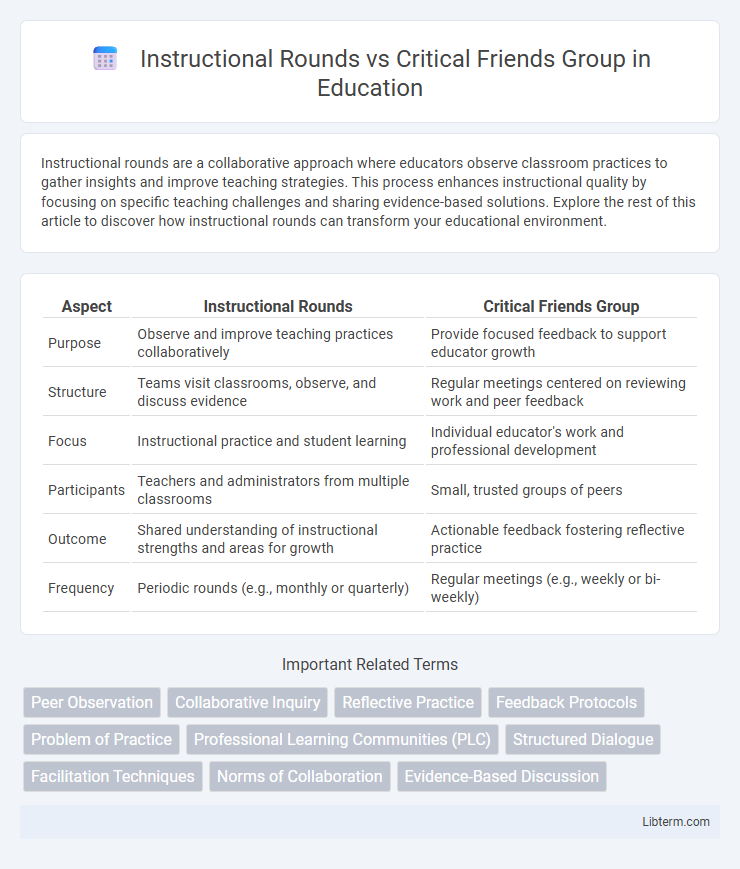Instructional rounds are a collaborative approach where educators observe classroom practices to gather insights and improve teaching strategies. This process enhances instructional quality by focusing on specific teaching challenges and sharing evidence-based solutions. Explore the rest of this article to discover how instructional rounds can transform your educational environment.
Table of Comparison
| Aspect | Instructional Rounds | Critical Friends Group |
|---|---|---|
| Purpose | Observe and improve teaching practices collaboratively | Provide focused feedback to support educator growth |
| Structure | Teams visit classrooms, observe, and discuss evidence | Regular meetings centered on reviewing work and peer feedback |
| Focus | Instructional practice and student learning | Individual educator's work and professional development |
| Participants | Teachers and administrators from multiple classrooms | Small, trusted groups of peers |
| Outcome | Shared understanding of instructional strengths and areas for growth | Actionable feedback fostering reflective practice |
| Frequency | Periodic rounds (e.g., monthly or quarterly) | Regular meetings (e.g., weekly or bi-weekly) |
Introduction to Instructional Rounds and Critical Friends Group
Instructional Rounds involve educators observing classroom practices to identify strengths and areas for improvement through structured, non-evaluative visits, promoting a culture of continuous learning and collaboration. Critical Friends Groups consist of small teams of educators who provide constructive feedback through reflective dialogue, fostering trust and professional growth in a supportive environment. Both approaches prioritize reflective practice but differ in format and focus, with Instructional Rounds emphasizing observational learning and Critical Friends Groups centered on peer feedback conversations.
Defining Instructional Rounds: Purpose and Process
Instructional Rounds involve educators systematically observing classroom practices to gather data on teaching and learning, with the purpose of identifying effective strategies and areas for improvement. This collaborative process includes pre-observation meetings, focused observations, and post-observation discussions that emphasize evidence-based feedback and shared learning. The goal is to build collective capacity for instructional improvement through structured, non-evaluative dialogues focused on student engagement and instructional methods.
Understanding Critical Friends Group: Core Elements
Critical Friends Group (CFG) centers on structured peer collaboration to enhance teaching and learning through reflective dialogue, feedback, and support among educators. Core elements include consistent, trust-based meetings, evidence-based discussions, and focused protocols that promote honest critique and professional growth. This model fosters a safe environment where educators critically examine practice, share expertise, and collaboratively develop improvement strategies.
Key Similarities Between Instructional Rounds and Critical Friends Group
Instructional Rounds and Critical Friends Groups both emphasize collaborative teacher inquiry to improve instructional practices through structured peer observations and feedback. Both approaches foster a culture of trust and reflective dialogue, enabling educators to analyze and refine teaching strategies based on evidence gathered from classroom interactions. They prioritize collective responsibility for student learning outcomes by engaging diverse perspectives to identify challenges and generate actionable solutions.
Distinct Differences: Instructional Rounds vs Critical Friends Group
Instructional Rounds involve collaborative classroom observations focused on identifying instructional practices and student learning progress, emphasizing data-driven feedback for continuous improvement. Critical Friends Group centers on structured peer coaching and reflective dialogue among educators to enhance teaching strategies and foster professional growth. The key distinction lies in Instructional Rounds prioritizing observational analysis of teaching practices, while Critical Friends Group emphasizes collaborative reflection and support.
Impact on Professional Development and Teacher Collaboration
Instructional Rounds foster professional development by engaging teachers in systematic classroom observations and collaborative discussions aimed at identifying best practices and areas for improvement. Critical Friends Groups enhance teacher collaboration through structured feedback cycles where educators critically reflect on their practice and receive constructive input from peers. Both approaches lead to improved instructional strategies and a culture of continuous learning, but Instructional Rounds emphasize observational data while Critical Friends Groups focus on reflective dialogue.
Role of Observation and Feedback in Both Models
Instructional Rounds emphasize systematic classroom observation to collect data on teaching practices and student engagement, fostering collaborative analysis and evidence-based feedback among educators. Critical Friends Groups rely on structured peer-to-peer observation coupled with reflective dialogue to provide constructive, trust-based feedback aimed at professional growth. Both models use observation and feedback as foundational tools to improve instructional effectiveness, but Instructional Rounds prioritize data-driven insights while Critical Friends Groups focus on reflective collaboration and relationship-building.
Implementation Challenges and Solutions
Instructional Rounds face implementation challenges such as scheduling conflicts among educators and resistance to peer observation due to fear of judgment; solutions include establishing clear protocols and fostering a culture of trust through regular, low-stakes observations. Critical Friends Groups often struggle with maintaining consistent participation and managing divergent opinions, which can be addressed by defining roles, setting norms for constructive feedback, and facilitating skilled moderation to ensure productive dialogue. Both approaches benefit from leadership support and ongoing professional development to sustain engagement and effectiveness in collaborative teacher improvement.
Evidence of Effectiveness: Research and Case Studies
Instructional Rounds have demonstrated effectiveness through research highlighting improved teaching practices and student outcomes by fostering collaborative observation and feedback cycles among educators. Critical Friends Groups show evidence of increasing reflective practice and professional growth, supported by case studies that emphasize peer support and structured dialogue for continuous improvement. Both approaches contribute to school improvement, yet Instructional Rounds provide more robust data linking observational feedback to measurable instructional enhancements.
Choosing the Right Model for Your School Context
Selecting between Instructional Rounds and Critical Friends Group depends on your school's specific goals and culture. Instructional Rounds are ideal for schools seeking systematic, observational walkthroughs to enhance instructional practices through collective evidence-based analysis. Critical Friends Groups work best in environments valuing peer feedback and reflective dialogue to foster professional growth and collaborative problem-solving.
Instructional Rounds Infographic

 libterm.com
libterm.com